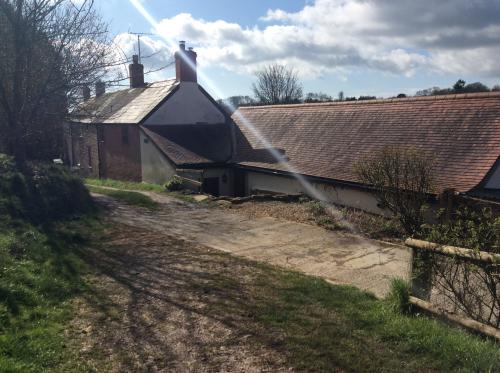The Princess, The Politician and The Pub
The question people always ask is: “Why is it called Stumps?” Research into the history of the property has yet to throw up an answer but it has produced some interesting details about the house, the land it is built on and the people who have lived there.
Where is it?
Stumps is on the very edge of Oxbridge, the hamlet around one mile south of Netherbury. It is the first property in Oxbridge you come to if you are walking along the public bridleway from Netherbury and the first house on the east side of the Brit after you pass River Cottage, made famous by Hugh Fearnley-Whittingstall in his TV series. If you are driving through Oxbridge down Camesworth Lane and turn up the concrete-based bridleway, it is the last house you will come to at the top of the dead-end. The Brit runs through the bottom of the property and separates Oxbridge from the Slape Estate in Waytown, formerly a vehicle scrapyard.
The Pub
In the early 19th century a small terrace of stone cottages for workers at Slape Mill was built on the site. It certainly pre-dates 1835 when it features on the local Tithe Maps. The owner was Thomas Park and the occupier John Hansford. At some point later in the 19th century, it became a pub selling cider and beer to millworkers and was known as the Crown Inn. It may well have previously been called The Freeman’s Tavern as a pub of that name is mentioned in the 1871 census for Oxbridge and it seems unlikely there would have been two hostelries in different locations in such a small place. James Scadden was the innkeeper in 1871. In the 1891 census Simon Bowditch is the occupier of ‘Crown’s Farm’ and he is also described as an innkeeper so was presumably running the Crown Inn. Around two to three acres of land between the cottages and the river belonged to the property and was bought and sold under the name of Chasehay Mead, or sometimes Chessey Mead. These days the land is used as a goat field. By 1911 the innkeeper was one Benjamin Ellis.
Palmers
The Crown Inn was bought by Palmers, the Bridport brewers, in 1893. They sold it by auction in 1919, not long after the First World War, following which it ceased to be a pub. The auction shows it was listed as three freehold cottages. The Crown Inn was number one and consisted of a parlour, living room, kitchen, pantry and four bedrooms let to Mr R. Fone at a rent of £7 16s per annum. Lots two and three each contained a living, kitchen and two bedrooms, let to Messrs Seal and Salisbury at a total rent of £8 9s per annum. By this time the cottages had probably already been built on to the north by a substantial brick extension. It is around this time that the name Stumps first crops up but in the singular. So where we now have Stumps Cottage, we had numbers 1, 2 and 3 Stump Cottages.
The Politician
The property went through various different owners until the 1970s when it was bought by William Waldegrave, later to become a cabinet minister in Margaret Thatcher’s Conservative government. He was a co-owner with Helen Dorrien-Smith, a daughter of Major Arthur Algernon Smith-Dorrien-Smith, who had been Lord Proprietor of the Scilly Islands. Neither of the owners lived at Stumps which was rented out to Alexandra Dorrien-Smith, the niece of Helen, and to Alexandra’s husband Gerry Burrows. The connection between Waldegrave and the Dorrien-Smiths was not immediately obvious but it became clear on reading the politician’s memoirs entitled “A Different Kind of Weather”.
In it, Waldegrave recounts what happened to him when he went up from Eton to Oxford University.
“I fell in love. Alexandra ‘Whizz’ Dorrien-Smith, tall with long blond hair and legs that went on forever – was the perfect sixties girlfriend. If Francois Hardy herself was not immediately available, Whizz was just as good. And she came complete with another beautiful island, Tresco, in the Isles of Scilly. …My brother was already in love with the eldest (sister), while my cousin Charles O’Hagan, fell for their mother – the source of all their spectacular looks – which complicated matters.”
Waldegrave went on to say he and Whizz exchanged letters once and sometimes twice daily and that he retained a whole suitcase of her letters. Their relationship, though short-lived, clearly had a long-lasting effect even if both of them were to go on to marry other people.
The Princess
Alexandra’s mother, she of the spectacular looks, was Princess Tamara of Imeretinsky, a direct descendant of King George VII of Imereti, a kingdom in Georgia. She had married Helen’s brother Thomas Dorrien-Smith and a portrait of the married couple hangs in the National Gallery. When Waldegrave said his cousin falling for the mother had complicated matters, he was not joking. The Princess divorced her husband to marry Baron O’Hagan.
The Tragedy
Alexandra Dorrien-Smith, who had been born in the Scilly Islands, married Gerry Burrows in Bridport in April 1977. The marriage had lasted just 18 months when Gerry was killed in a motor cycle accident on the Bridport-Beaminster road in November 1978. He was 31. They had one child, Jesse.
The couple had planned to build a workshop at the cottage and Alexandra decided to go ahead with the help of two builders Gerry had engaged. She left a message to her husband and placed it in a bottle which was buried in the wall of the extension.
The bottle and message were found in 2011 by Chris Maxwell, who lived in the cottage from 2003 to 2012, when he built the new Green Oak Room. He re-buried it in the roof of the new extension after transcribing the message.
This is what it said:
Gerry’s Workshop.
Mike and John, friends of ours, have nearly finished building what was going to be Gerry’s (my husband for want of a better word, and father of Jesse) workshop. For about two years we gathered the materials, stone, beams, windows and Gerry was going to begin building it after Christmas 1978. Gerry was killed (8 Nov 1978) riding his motor bike to work when he hit a milk tanker. No-one knows what happened only that he died.
I decided to go ahead with building the workshop and the building of it has been hard in some ways, the rain and sleet and freezing cold and hard mentally and emotionally because of Gerry being dead; John, Mike and I were all upset at times and felt Gerry’s presence. I hope Gerry likes it. John and Mike have done a lovely job. I guess I just wish Gerry could have built it himself.
Well my love it’s nearly done. It’s been so weird building it without you, when three years of waiting and planning had all just come together. Me and Jess will use it but I’ll always think of it as yours.
I love you, Whizz
Research is continuing into Stumps and it is hoped this entry will be updated in due course. One other mystery is why the postal address of the property is 4 Oxbridge, rather than Stumps Cottage. There is nothing in any of the property documents suggesting this address or the number 4 and there is no number 1, 2 or 3 Oxbridge.



